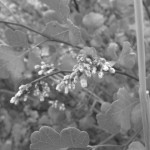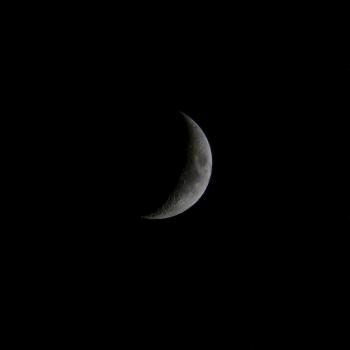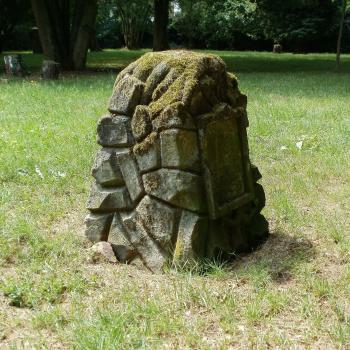The apotheosis of the Dierne is celebrated at the end of this month – July 31st. For this reason, I have been super busy lately. (That, and I was struck down with a cold.) In order to keep my blogging here on Patheos up while also not slacking off on my religious duties, most of the posts for the rest of this month will focus on the apotheosis.
The apotheosis of the Dierne is one of the most important holy days in the Otherfaith (the other being Reunion, a celebration starting December 25th and lasting until New Year’s Eve). We celebrate a variety of things on this day, though it is mainly about the Dierne becoming a god. What we focus on, though, are the events leading up to his deification. I’ll be posting myths over on Tumblr and my main Otherfaith blog as we get even closer to the holy day. Here on this blog I’ll be covering how to celebrate the apotheosis and give proper respect to the Dierne.
As I’ve been writing this mythology, I’ve realized just how finicky the myths are. The gods and faeries will repeatedly flap their hands at me and tell me five versions of the same tale. Originally, I thought it was just my being incompetent at listening (which it has been, at some points), but now I think I can safely attribute the varieties and changes to these being myths. And myths wobble and twist in all sorts of directions. My problem now lies in figuring out how to structure these stories so that they make the most sense to readers.
Even with all the variations, there are consistencies. Whatever the surrounding structure, the Dierne always comes into his power through two things: empowerment and bloodshed. In the story that I plan to weave into the larger mythic book for the Otherfaith, the Dierne’s power is won after he shoots his brother and past lover, Mircea. In fact, the other consistency in the stories is that July 31st was the human date that the Dierne killed Mircea, no matter how the other details of the story change.
In the mythos, Mircea isn’t seen as an ‘evil’ figure. Every action that leads to his death has motives that we can trace and very likely relate to. He’s at times a ‘conflicted young man’ and a ‘dying star’, and what makes him ‘bad’ is not some inherent evil or flaw inside of him. His actions aren’t evil either – they just cause a lot of pain and, in some of the stories, oppression. I stress this because I think it’s important to remember that evil is not a specter that overtakes people and ‘makes them’ do bad things. We all have in us the capacity for horrifying acts. Mircea turns, in himself, that capacity into reality, and the Dierne receives much of the violence he metes out.
In one version of the myth, the Dierne is a revolutionary who strikes down the oppressive reign of Mircea and later on, after helping rebuild the Westernlands, is given a crown and made into a god. In another, the motive of revenge is much clearer. Mircea abuses the Dierne, and the Dierne lashes out.
They aren’t exactly bedtime stories.
While there are definitely themes and lessons that can be pulled from the stories, and which I hope to discuss as I post them publicly, I don’t think these are always tales telling us how to act. In the revolutionary myth it’s very clear that we’re being encouraged to take a stand against oppression, but in other myths I expect people to be left conflicted. I do not think these stories are so much about what is ‘right’ as they are presentations of what can be and what is.
I feel strongly that the Dierne is, as I’ve noted before, a modern god, and because of that he has connections to very modern experiences. Some of those are very, very violent, and I think that reflects in his stories.
*
There’s an interesting post on Meadowsweet & Myrrh that caught my eye the other day. Some of the points Alison Leigh Lily raises had my head turning about how we treat youth in our culture. The post prompted me to do a rereading of one of my favorite manga, Loveless, due to the engaging and complex role children have in the story. I’m hoping to write a post later on about my own experiences with my younger brother in terms of religion and spirituality, and just how different he and I am – and why that has nothing to do with age. (If we limit our perception of what children can perceive and experience, we’ll miss out on a lot of interesting observations they make.)
The Otherfaith virtual shrine has been getting some activity, and for that I am incredibly grateful! Each person that requests an offering makes me (and the gods!) happy, and giving the offerings has turned up some interesting responses from the gods that help assure me I’m pursuing the correct path.
I have far too many journals waiting to be filled with writing, and far too many already being filled. It is amazing how much writing one can get done in regards to religion alone.
A note: the block button is your friend. If you’re on social media of some kind, figure out how to use it. Whether you just want to block media you’re not interested in or need to block someone who is harassing you, it will make your life incredibly easier. Don’t feel bad for using it. It’s a lovely little tool, and it exists for a reason.
Happy Teen Wolf day everyone. (I’ll be catching up with the latest of that on Wednesday.)
















